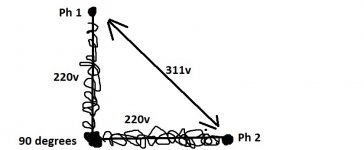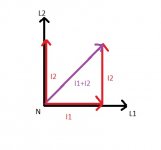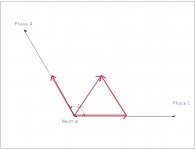Joethemechanic
Senior Member
- Location
- Hazleton Pa
- Occupation
- Electro-Mechanical Technician. Industrial machinery
Ok as I am reading the thread I am not getting a clear answer as to the math. I know that phase vectors change things a lot. I'm from philly and very used to working on single, two, and three phase systems,. The diagram below is a 3 wire 2 phase old school Philly transformer secondary. As you can see there are 3 phases available from this connection. As three phase the vectors are nonstandard and we never use the 311 volt phase, but it's still there. For a balanced load on phases 1 and 2 the current on the conductor connected to the 90 degree point will be the current of either phase times the square root of 2 (1.41)







